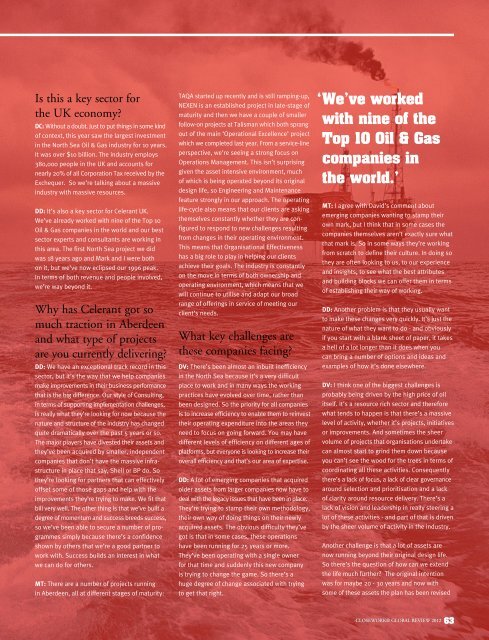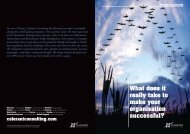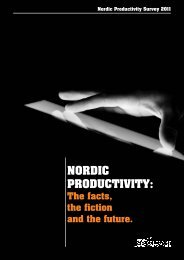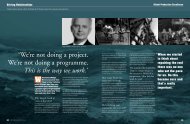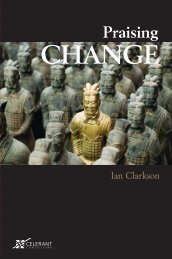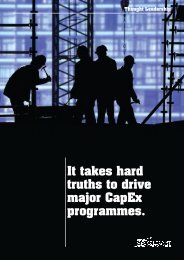download - Celerant Consulting
download - Celerant Consulting
download - Celerant Consulting
- No tags were found...
You also want an ePaper? Increase the reach of your titles
YUMPU automatically turns print PDFs into web optimized ePapers that Google loves.
Is this a key sector forthe UK economy?DC: Without a doubt. Just to put things in some kindof context, this year saw the largest investmentin the North Sea Oil & Gas industry for 10 years.It was over $10 billion. The industry employs380,000 people in the UK and accounts fornearly 20% of all Corporation Tax received by theExchequer. So we’re talking about a massiveindustry with massive resources.DD: It’s also a key sector for <strong>Celerant</strong> UK.We’ve already worked with nine of the Top 10Oil & Gas companies in the world and our bestsector experts and consultants are working inthis area. The first North Sea project we didwas 18 years ago and Mark and I were bothon it, but we’ve now eclipsed our 1996 peak.In terms of both revenue and people involved,we’re way beyond it.Why has <strong>Celerant</strong> got somuch traction in Aberdeenand what type of projectsare you currently delivering?DD: We have an exceptional track record in thissector, but it’s the way that we help companiesmake improvements in their business performancethat is the big difference. Our style of <strong>Consulting</strong>,in terms of supporting implementation challenges,is really what they’re looking for now because thenature and structure of the industry has changedquite dramatically over the past 5 years or so.The major players have divested their assets andthey’ve been acquired by smaller, independentcompanies that don’t have the massive infrastructurein place that say, Shell or BP do. Sothey’re looking for partners that can effectivelyoffset some of those gaps and help with theimprovements they’re trying to make. We fit thatbill very well. The other thing is that we’ve built adegree of momentum and success breeds success,so we’ve been able to secure a number of programmessimply because there’s a confidenceshown by others that we’re a good partner towork with. Success builds an interest in whatwe can do for others.MT: There are a number of projects runningin Aberdeen, all at different stages of maturity:TAQA started up recently and is still ramping-up,NEXEN is an established project in late-stage ofmaturity and then we have a couple of smallerfollow-on projects at Talisman which both sprangout of the main ‘Operational Excellence’ projectwhich we completed last year. From a service-lineperspective, we’re seeing a strong focus onOperations Management. This isn’t surprisinggiven the asset intensive environment, muchof which is being operated beyond its originaldesign life, so Engineering and Maintenancefeature strongly in our approach. The operatinglife-cycle also means that our clients are askingthemselves constantly whether they are configuredto respond to new challenges resultingfrom changes in their operating environment.This means that Organisational Effectivenesshas a big role to play in helping our clientsachieve their goals. The industry is constantlyon the move in terms of both ownership andoperating environment, which means that wewill continue to utilise and adapt our broadrange of offerings in service of meeting ourclient’s needs.What key challenges arethese companies facing?DV: There’s been almost an inbuilt inefficiencyin the North Sea because it’s a very difficultplace to work and in many ways the workingpractices have evolved over time, rather thanbeen designed. So the priority for all companiesis to increase efficiency to enable them to reinvesttheir operating expenditure into the areas theyneed to focus on going forward. You may havedifferent levels of efficiency on different ages ofplatforms, but everyone is looking to increase theiroverall efficiency and that’s our area of expertise.DD: A lot of emerging companies that acquiredolder assets from larger companies now have todeal with the legacy issues that have been in place.They’re trying to stamp their own methodology,their own way of doing things on their newlyacquired assets. The obvious difficulty they’vegot is that in some cases, these operationshave been running for 25 years or more.They’ve been operating with a single ownerfor that time and suddenly this new companyis trying to change the game. So there’s ahuge degree of change associated with tryingto get that right.‘ We’ve workedwith nine of theTop 10 Oil & Gascompanies inthe world.’MT: I agree with David’s comment aboutemerging companies wanting to stamp theirown mark, but I think that in some cases thecompanies themselves aren’t exactly sure whatthat mark is. So in some ways they’re workingfrom scratch to define their culture. In doing sothey are often looking to us, to our experienceand insights, to see what the best attributesand building blocks we can offer them in termsof establishing their way of working.DD: Another problem is that they usually wantto make these changes very quickly. It’s just thenature of what they want to do - and obviouslyif you start with a blank sheet of paper, it takesa hell of a lot longer than it does when youcan bring a number of options and ideas andexamples of how it’s done elsewhere.DV: I think one of the biggest challenges isprobably being driven by the high price of oilitself. It’s a resource rich sector and thereforewhat tends to happen is that there’s a massivelevel of activity, whether it’s projects, initiativesor improvements. And sometimes the sheervolume of projects that organisations undertakecan almost start to grind them down becauseyou can’t see the wood for the trees in terms ofcoordinating all these activities. Consequentlythere’s a lack of focus, a lack of clear governancearound selection and prioritisation and a lackof clarity around resource delivery. There’s alack of vision and leadership in really steering alot of these activities - and part of that is drivenby the sheer volume of activity in the industry.Another challenge is that a lot of assets arenow running beyond their original design life.So there’s the question of how can we extendthe life much further? The original intentionwas for maybe 20 - 30 years and now withsome of these assets the plan has been revisedCLOSEWORK® GLOBAL REVIEW 2012 63 67


